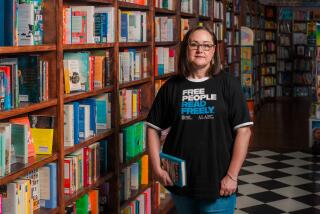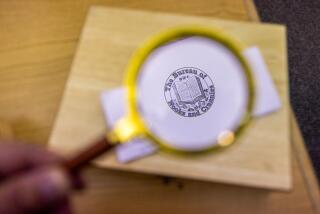A Bibliophile Takes Her Dream Off the Shelf
Man should treasure books because they have guided him to truth; they have filled his mind with noble and graceful images; they stood by him in all vicissitudes, comforters in sorrow, nurses in sickness, companions in solitude.
--Thomas Macaulay
*
Gunnel Cole refers to her home library as a room were she can dream in any direction.
“No matter which way I look, there are favorite things: books, souvenirs from trips I took with my late husband, Robert, photographs of my family, and artworks made by family and friends,” says Cole, who lives in Costa Mesa.
Cole knows she’s lucky to have a room set aside as a library. “This is the first real library I’ve ever had. In our other houses, the books were mainly in the den,” she says of her collection that numbers more than 1,000 books--some of which, more than two centuries old, she found in the attic in her family farm in Sweden. “When we moved here 10 years ago, we took the room the previous owners used as a master bedroom, added a bay window and put in a coffered ceiling.”
Private libraries became popular among 18th century upper classes who started collecting books as status symbols. The books were handprinted, leather-bound and embossed with gold. It wasn’t absolutely necessary to read them. Today, books are valued more for reference and pleasure, except for antique books, which are prized by serious collectors. In 1983, the “Gospels of Henry the Lion,” an elaborate work burnished with gold around 1180 for the duke of Saxony and Bavaria, sold for $15 million, a world-record price for a work of art until the sale of Van Gogh’s “Sunflowers” for $39.9 million in 1987.
It’s possible, however, to start a book collection on a limited budget. The easiest way is to pick a theme for the collection and hunt secondhand stores, garage sales and flea markets for books relating to the theme.
Once you decide to create a library in your home, your considerations include installing proper lighting and shelving and protecting the books from damage.
Most people buy light fixtures because they look good, not because of their functions. Without proper lighting, there can be glare that makes the book’s pages hard to read and can can cause eyestrain, fatigue and headaches.
The light on the book you’re reading should be brighter than your surroundings but should not contrast sharply with the light around you, says lighting expert Peter Barna. In his book “At Home With Books” (Carol Southern Books, 1995, $50), he writes that there should be a “coziness” to the room. The light should also be changed if the reading is for business or pleasure: Financial reports may require stronger lighting than fiction.
Chris Bradley, the project architect for the Newport Beach Public Library, says, “The lighting was a huge consideration when we planned the library. We worked closely with lighting designer Jan Myer in San Rafael to get the most energy-efficient lighting we could.”
They installed high-intensity, energy-efficient discharge lighting and florescent lighting that approximates daylight and doesn’t have the annoying flickering that is often found in florescent lighting.
“We used natural light as much as possible. The tall windows let in lots of light, and the exposed structure of the building also allows more light in,” says Bradley.
Because sunlight can damage books and lead to glare and reading discomfort, Bradley had the library’s windows tinted.
For the homeowner, the traditional library lamp placed in the middle of the desk in front of the reader is not a good choice. Standing and table lamps should be placed slightly behind the reader and directly over the left or right shoulder.
Another consideration for a library is the shelving. Linda Braverman of Yamada Enterprises in Huntington Beach, which constructs library interiors, says most people don’t consider the sag quotient when building bookshelves.
“Books are very heavy, and unless the shelves are short enough and reinforced, they will sag,” she says.
The company uses metal shelves for most of its commercial library installations, but, she says, many homeowners prefer built-in units made of solid woods, such as mahogany, maple and oak. Shelving should be 1 inch thick, 36 inches long and 10 1/2 inches deep to accommodate a collection of books.
“Most homeowners seem to like the floor-to-ceiling bookshelves,” says Braverman. “We use ladders that run on tracks so they can easily reach any book.”
Caring for books means protecting them from fire, water, gas, heat, light, bugs, dust and neglect.
Books should be dusted at least twice a year. Start by cleaning the top edge of the book and then dust and vacuum away from the spine. Hold the book tightly so the dust does not work its way into the pages.
If taken care of properly, books can last a long time and be passed done through the generations, just as Gunnel Cole’s family passed its to her.
More to Read
Sign up for our Book Club newsletter
Get the latest news, events and more from the Los Angeles Times Book Club, and help us get L.A. reading and talking.
You may occasionally receive promotional content from the Los Angeles Times.







